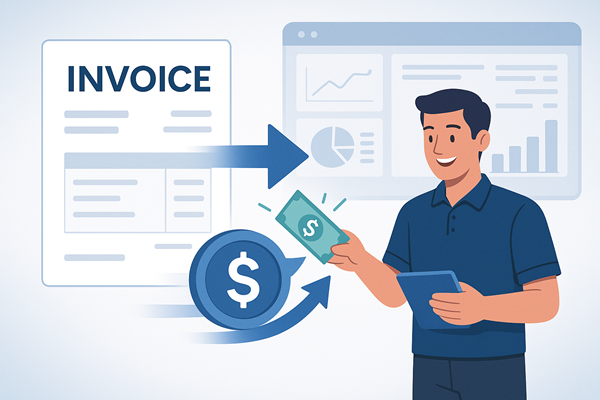Discover how invoice factoring helps Australian scale-ups boost cash flow, avoid debt, and grow faster without giving up equity or control.
Key takeaways
If you only read one section, make it this one:
- Invoice factoring unlocks up to 95% of your unpaid invoices within 24 hours, giving your startup fast access to working capital without taking on debt.
- Over 61% of Australian SMEs experience late payments, with average delays of 6.4 days past due, choking growth potential (Xero Small Business Insights, 2024).
- Cash flow stress is a top reason 38% of Australian startups fail within the first 4 years.
- Factoring offers flexibility—you choose which invoices to fund, without being locked into long-term contracts.
- No equity dilution—invoice factoring doesn’t impact ownership or valuation, making it ideal for fast-growing scale-ups needing to invest in talent, tech or stock.
- Works across industries—tech, wholesale, construction, freight, and services businesses can all benefit from factoring solutions tailored to their needs.
Introduction: Fast growth needs fast cash flow
Scaling a startup in Australia is no small feat—especially when your biggest clients pay late, yet your bills don’t wait. You’re investing in people, platforms, and product development, but slow cash flow can stall progress just when you're gaining momentum.
That’s where invoice factoring comes in. It’s a practical, debt-free way to turn your receivables into ready-to-use cash. Unlike loans or overdrafts, factoring doesn’t add to your liabilities or require personal guarantees. And in today’s uncertain market, it’s fast becoming a preferred funding option for savvy founders and scale-up operators.
Let’s break down exactly how invoice factoring works, why it’s booming in Australia, and how your business can use it to fund sustainable, scalable growth—without going into the red.
What is invoice factoring?
Invoice factoring is a type of accounts receivable finance. Instead of waiting 30, 60, or even 90 days for your customers to pay, you sell your unpaid invoices to a factoring company. In return, you get most of the invoice value upfront—usually 80% to 95%—and the rest (minus a small fee) when your customer pays.
It’s a funding model that suits high-growth, B2B businesses with regular invoicing cycles and strong customer relationships.
How it works in four simple steps:
- Issue your invoice to a customer for completed work.
- Submit the invoice to a factoring provider.
- Get paid fast—receive 80–95% of the invoice value within 24 hours.
- Customer pays the invoice (often to a dedicated account managed by the factoring company), and you receive the balance minus a service fee.
Why invoice factoring is rising in Australia
In 2025, cash flow is king—and for good reason. According to the Australian Bureau of Statistics (ABS), over 40% of small businesses reported cash flow issues in the past 12 months. The cause? A combination of late payments, interest rate pressure, and rising operational costs.
Invoice factoring is growing in popularity because it:
- Improves liquidity without impacting your balance sheet.
- Provides flexibility during growth spurts or seasonal demand.
- Offers predictable funding when you’re waiting on large invoices.
A 2023 report by IBISWorld highlighted that the invoice factoring industry in Australia is valued at $6.5 billion, with fintech-led growth driving new adoption, especially among digital-native startups and tech-enabled businesses.
Who is invoice factoring for?
Invoice factoring isn’t just for struggling businesses—it’s a smart growth enabler. Here’s how different business types can benefit:
Startups:
- Avoid early-stage debt or equity dilution.
- Fund product launches or marketing campaigns quickly.
- Meet payroll while waiting on enterprise clients to pay.
Scale-ups:
- Fuel rapid hiring, R&D, or expansion into new markets.
- Support larger order volumes without relying on venture capital.
- Maintain runway without raising another round prematurely.
Industry sectors thriving with factoring:
- Logistics & transport: Smooth over long invoice cycles from freight brokers.
- Construction: Bridge payments while managing staggered contractor timelines.
- Professional services: Get paid faster for work delivered to large corporates.
- Wholesale & manufacturing: Finance bulk stock purchases to meet larger POs.
- SaaS & tech: Scale faster by unlocking cash tied up in enterprise contracts.
The pros and cons at a glance
Pros:
- Immediate cash flow to reinvest in your business.
- No new debt or repayments on your books.
- No dilution—retain full control and equity.
- Scales with your sales—the more invoices you generate, the more funding you access.
- Easy qualification—approval based on your customers’ creditworthiness, not yours.
Cons:
- Fees apply—usually 1% to 5% per invoice depending on terms and risk.
- Customer contact—some factoring providers contact your clients directly (though many offer confidential options).
- May not suit B2C businesses or those with low invoice values.
Choosing the right factoring provider in Australia
Not all factoring companies are created equal. Here’s what to look for:
Key factors to consider:
- Advance rate: How much cash will you receive upfront?
- Fee structure: Are fees flat or variable based on invoice terms?
- Customer experience: Will your client relationships be managed professionally?
- Contract terms: Is there a lock-in period or minimum monthly volume?
- Online tools: Does the platform offer digital onboarding and dashboard visibility?
How invoice factoring stacks up against other funding options
When you're running a fast-growing startup or scale-up, choosing the right funding source can be make or break. Here’s how invoice factoring compares to some of the most common alternatives available to Australian businesses in 2025:
- Invoice factoring:
Perfect if you need cash fast and don’t want to take on debt. You can typically access funds within 24 hours of issuing an invoice, without giving up any equity or taking on loan repayments. It scales naturally with your business—more invoices mean more available cash—and approval is usually based on your customers’ creditworthiness rather than your own. - Business loans:
These can be useful for major investments or long-term capital needs like equipment or fit-out costs. However, they involve taking on debt, require a strong credit profile, and can take 2 to 4 weeks for approval and funding. You’ll also need to budget for regular repayments and interest, which can add pressure during slower months. - Equity funding (VC or angel investment):
Great for ambitious growth plans where capital and mentorship go hand-in-hand. But it takes time—often 2 to 6 months or longer—and you’ll need to part with a portion of your ownership, which can dilute control over your vision or strategy. Use this option when strategic alignment matters more than immediate cash flow. - Overdraft facility:
A flexible, short-term option for plugging gaps in working capital. It’s linked to your business bank account and can be accessed quickly—within a week or two. But it's still a form of debt, usually comes with high interest rates, and may require personal guarantees or collateral. - Line of credit:
Similar to an overdraft, this option gives you an agreed borrowing limit you can draw from as needed. It’s useful for managing fluctuating costs, but again, it adds to your debt load and involves interest charges and often setup fees.
Each option has its place, but if you’re aiming for speed, flexibility, and minimal risk, invoice factoring gives you the edge—especially when you’re sitting on a stack of invoices waiting to be paid.
FAQs: What other startups ask about invoice factoring
Is invoice factoring the same as invoice financing?
Not quite. With factoring, the provider takes over invoice collection. With financing, you retain responsibility for collecting the debt, and the invoice is used as collateral for a short-term loan.
Will my customers know I’m using factoring?
Not always. Many providers offer confidential factoring, so your clients won’t be aware. Ask upfront if you want discretion.
What fees should I expect?
Typically between 1% and 5% of the invoice value, depending on the provider, the credit risk of your customer, and how long the invoice takes to be paid.
Can I choose which invoices to factor?
Yes—most providers offer selective or spot factoring, so you only factor the invoices you choose, when you need.
Is invoice factoring regulated in Australia?
Yes. Providers must comply with ASIC guidelines, and many reputable factoring firms are AFCA members offering external dispute resolution services.
Conclusion: Growth without the growing pains
Invoice factoring is no longer just a fallback for struggling businesses. In 2025, it’s a forward-thinking way to support fast, flexible, and sustainable growth—especially in Australia’s startup ecosystem where cash flow is often the biggest bottleneck.
By using your unpaid invoices to access working capital instantly, you can seize new opportunities, invest in your team, or scale operations without taking on debt or giving up equity.
If you’re a founder or operator looking to grow without compromise, invoice factoring might be the funding solution you’ve been looking for.


